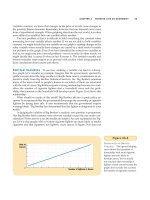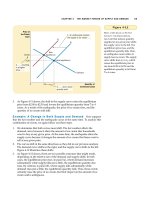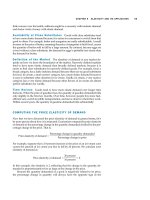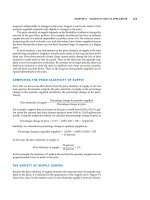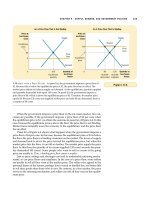Tài liệu Ten Principles of Economics - Part 70 ppt
Bạn đang xem bản rút gọn của tài liệu. Xem và tải ngay bản đầy đủ của tài liệu tại đây (222.66 KB, 10 trang )
CHAPTER 31 AGGREGATE DEMAND AND AGGREGATE SUPPLY 715
be viewed as decreasing the quantity of goods and services supplied and shifting
the long-run aggregate-supply curve to the left.
A NEW WAY TO DEPICT
LONG-RUN GROWTH AND INFLATION
Having introduced the economy’s aggregate-demand curve and the long-run
aggregate-supply curve, we now have a new way to describe the economy’s long-
run trends. Figure 31-5 illustrates the changes that occur in the economy from
decade to decade. Notice that both curves are shifting. Although there are many
forces that govern the economy in the long run and can in principle cause such
shifts, the two most important in practice are technology and monetary policy.
Technological progress enhances the economy’s ability to produce goods and ser-
vices, and this continually shifts the long-run aggregate-supply curve to the right.
At the same time, because the Fed increases the money supply over time, the
aggregate-demand curve also shifts to the right. As the figure illustrates, the result
is trend growth in output (as shown by increasing Y) and continuing inflation (as
shown by increasing P). This is just another way of representing the classical
analysis of growth and inflation we conducted in Chapters 24 and 28.
The purpose of developing the model of aggregate demand and aggregate
supply, however, is not to dress our long-run conclusions in new clothing. Instead,
Quantity of
Output
Y
1980
AD
1980
Y
1990
AD
1990
Y
2000
Aggregate
Demand,
AD
2000
Price
Level
0
Long-run
aggregate
supply,
LRAS
1980
LRAS
1990
LRAS
2000
P
1980
1. In the long run,
technological
progress shifts
long-run aggregate
supply . . .
4. . . . and
ongoing inflation.
3. . . . leading to growth
in output . . .
P
1990
P
2000
2. . . . and growth in the
money supply shifts
aggregate demand . . .
Figure 31-5
L
ONG
-R
UN
G
ROWTH AND
I
NFLATION IN THE
M
ODEL OF
A
GGREGATE
D
EMAND AND
A
GGREGATE
S
UPPLY
. As the
economy becomes better able to
produce goods and services over
time, primarily because of
technological progress, the long-
run aggregate-supply curve shifts
to the right. At the same time, as
the Fed increases the money
supply, the aggregate-demand
curve also shifts to the right. In
this figure, output grows from
Y
1980
to Y
1990
and then to Y
2000
, and
the price level rises from P
1980
to
P
1990
and then to P
2000
. Thus, the
model of aggregate demand and
aggregate supply offers a new
way to describe the classical
analysis of growth and inflation.
716 PART TWELVE SHORT-RUN ECONOMIC FLUCTUATIONS
it is to provide a framework for short-run analysis, as we will see in a moment. As
we develop the short-run model, we keep the analysis simple by not showing the
continuing growth and inflation depicted in Figure 31-5. But always remember
that long-run trends provide the background for short-run fluctuations. Short-run
fluctuations in output and the price level should be viewed as deviations from the continu-
ing long-run trends.
WHY THE AGGREGATE-SUPPLY CURVE
SLOPES UPWARD IN THE SHORT RUN
We now come to the key difference between the economy in the short run and
in the long run: the behavior of aggregate supply. As we have already discussed,
the long-run aggregate-supply curve is vertical. By contrast, in the short run, the
aggregate-supply curve is upward sloping, as shown in Figure 31-6. That is, over
a period of a year or two, an increase in the overall level of prices in the economy
tends to raise the quantity of goods and services supplied, and a decrease in the
level of prices tends to reduce the quantity of goods and services supplied.
What causes this positive relationship between the price level and output?
Macroeconomists have proposed three theories for the upward slope of the short-
run aggregate-supply curve. In each theory, a specific market imperfection causes
the supply side of the economy to behave differently in the short run than it does
in the long run. Although each of the following theories will differ in detail, they
share a common theme: The quantity of output supplied deviates from its long-
run, or “natural,” level when the price level deviates from the price level that
people expected. When the price level rises above the expected level, output rises
above its natural rate, and when the price level falls below the expected level, out-
put falls below its natural rate.
Quantity of
Output
Price
Level
0
Short-run
aggregate
supply
Y
2
Y
1
1. A decrease
in the price
level . . .
2. . . . reduces the quantity
of goods and services
supplied in the short run.
P
1
P
2
Figure 31-6
T
HE
S
HORT
-R
UN
A
GGREGATE
-
S
UPPLY
C
URVE
. In the short run,
a fall in the price level from P
1
to
P
2
reduces the quantity of output
supplied from Y
1
to Y
2
. This
positive relationship could be
due to misperceptions, sticky
wages, or sticky prices. Over
time, perceptions, wages, and
prices adjust, so this positive
relationship is only temporary.
CHAPTER 31 AGGREGATE DEMAND AND AGGREGATE SUPPLY 717
The Misperceptions Theory
One approach to the short-run aggregate-
supply curve is the misperceptions theory. According to this theory, changes in the
overall price level can temporarily mislead suppliers about what is happening in
the individual markets in which they sell their output. As a result of these short-
run misperceptions, suppliers respond to changes in the level of prices, and this
response leads to an upward-sloping aggregate-supply curve.
To see how this might work, suppose the overall price level falls below the
level that people expected. When suppliers see the prices of their products fall,
they may mistakenly believe that their relative prices have fallen. For example,
wheat farmers may notice a fall in the price of wheat before they notice a fall in the
prices of the many items they buy as consumers. They may infer from this obser-
vation that the reward to producing wheat is temporarily low, and they may re-
spond by reducing the quantity of wheat they supply. Similarly, workers may
notice a fall in their nominal wages before they notice a fall in the prices of the
goods they buy. They may infer that the reward to working is temporarily low and
respond by reducing the quantity of labor they supply. In both cases, a lower price
level causes misperceptions about relative prices, and these misperceptions induce sup-
pliers to respond to the lower price level by decreasing the quantity of goods and services
supplied.
The Sticky-Wage Theory
A second explanation of the upward slope of
the short-run aggregate-supply curve is the sticky-wage theory. According to this
theory, the short-run aggregate-supply curve slopes upward because nominal
wages are slow to adjust, or are “sticky,” in the short run. To some extent, the slow
adjustment of nominal wages is attributable to long-term contracts between work-
ers and firms that fix nominal wages, sometimes for as long as three years. In ad-
dition, this slow adjustment may be attributable to social norms and notions of
fairness that influence wage setting and that change only slowly over time.
To see what sticky nominal wages mean for aggregate supply, imagine that a
firm has agreed in advance to pay its workers a certain nominal wage based on
what it expected the price level to be. If the price level P falls below the level that
was expected and the nominal wage remains stuck at W, then the real wage W/P
rises above the level the firm planned to pay. Because wages are a large part of a
firm’s production costs, a higher real wage means that the firm’s real costs have
risen. The firm responds to these higher costs by hiring less labor and producing
a smaller quantity of goods and services. In other words, because wages do not ad-
just immediately to the price level, a lower price level makes employment and produc-
tion less profitable, which induces firms to reduce the quantity of goods and services
supplied.
The Sticky-Price Theory
Recently, some economists have advocated a
third approach to the short-run aggregate-supply curve, called the sticky-price the-
ory. As we just discussed, the sticky-wage theory emphasizes that nominal wages
adjust slowly over time. The sticky-price theory emphasizes that the prices of
some goods and services also adjust sluggishly in response to changing economic
conditions. This slow adjustment of prices occurs in part because there are costs to
adjusting prices, called menu costs. These menu costs include the cost of printing
and distributing catalogs and the time required to change price tags. As a result of
these costs, prices as well as wages may be sticky in the short run.
718 PART TWELVE SHORT-RUN ECONOMIC FLUCTUATIONS
To see the implications of sticky prices for aggregate supply, suppose that each
firm in the economy announces its prices in advance based on the economic con-
ditions it expects to prevail. Then, after prices are announced, the economy expe-
riences an unexpected contraction in the money supply, which (as we have
learned) will reduce the overall price level in the long run. Although some firms
reduce their prices immediately in response to changing economic conditions,
other firms may not want to incur additional menu costs and, therefore, may tem-
porarily lag behind. Because these lagging firms have prices that are too high, their
sales decline. Declining sales, in turn, cause these firms to cut back on production
and employment. In other words, because not all prices adjust instantly to changing
conditions, an unexpected fall in the price level leaves some firms with higher-than-desired
prices, and these higher-than-desired prices depress sales and induce firms to reduce the
quantity of goods and services they produce.
Summary
There are three alternative explanations for the upward slope of the
short-run aggregate-supply curve: (1) misperceptions, (2) sticky wages, and (3)
sticky prices. Economists debate which of these theories is correct. For our pur-
poses in this book, however, the similarities of the theories are more important
than the differences. All three theories suggest that output deviates from its nat-
ural rate when the price level deviates from the price level that people expected.
We can express this mathematically as follows:
ϭϩa
Ϫ
where a is a number that determines how much output responds to unexpected
changes in the price level.
Notice that each of the three theories of short-run aggregate supply empha-
sizes a problem that is likely to be only temporary. Whether the upward slope of
the aggregate-supply curve is attributable to misperceptions, sticky wages, or
sticky prices, these conditions will not persist forever. Eventually, as people adjust
their expectations, misperceptions are corrected, nominal wages adjust, and prices
become unstuck. In other words, the expected and actual price levels are equal
in the long run, and the aggregate-supply curve is vertical rather than upward
sloping.
WHY THE SHORT-RUN AGGREGATE-SUPPLY
CURVE MIGHT SHIFT
The short-run aggregate-supply curve tells us the quantity of goods and services
supplied in the short run for any given level of prices. We can think of this curve
as similar to the long-run aggregate-supply curve but made upward sloping by
the presence of misperceptions, sticky wages, and sticky prices. Thus, when think-
Expected
price level
Actual
price level
Natural rate of
output
Quantity of
output supplied
CHAPTER 31 AGGREGATE DEMAND AND AGGREGATE SUPPLY 719
ing about what shifts the short-run aggregate-supply curve, we have to consider
all those variables that shift the long-run aggregate-supply curve plus a new
variable—the expected price level—that influences misperceptions, sticky wages,
and sticky prices.
Let’s start with what we know about the long-run aggregate-supply curve. As
we discussed earlier, shifts in the long-run aggregate-supply curve normally arise
from changes in labor, capital, natural resources, or technological knowledge.
These same variables shift the short-run aggregate-supply curve. For example,
when an increase in the economy’s capital stock increases productivity, both the
long-run and short-run aggregate-supply curves shift to the right. When an in-
crease in the minimum wage raises the natural rate of unemployment, both the
long-run and short-run aggregate-supply curves shift to the left.
The important new variable that affects the position of the short-run
aggregate-supply curve is people’s expectation of the price level. As we have dis-
cussed, the quantity of goods and services supplied depends, in the short run, on
misperceptions, sticky wages, and sticky prices. Yet perceptions, wages, and prices
are set on the basis of expectations of the price level. So when expectations change,
the short-run aggregate-supply curve shifts.
To make this idea more concrete, let’s consider a specific theory of aggregate
supply—the sticky-wage theory. According to this theory, when people expect the
price level to be high, they tend to set wages high. High wages raise firms’ costs
and, for any given actual price level, reduce the quantity of goods and services that
firms supply. Thus, when the expected price level rises, wages rise, costs rise, and
firms choose to supply a smaller quantity of goods and services at any given actual
price level. Thus, the short-run aggregate-supply curve shifts to the left. Con-
versely, when the expected price level falls, wages fall, costs fall, firms increase
production, and the short-run aggregate-supply curve shifts to the right.
A similar logic applies in each theory of aggregate supply. The general lesson
is the following: An increase in the expected price level reduces the quantity of goods and
services supplied and shifts the short-run aggregate-supply curve to the left. A decrease in
the expected price level raises the quantity of goods and services supplied and shifts the
short-run aggregate-supply curve to the right. As we will see in the next section, this
influence of expectations on the position of the short-run aggregate-supply curve
plays a key role in reconciling the economy’s behavior in the short run with its be-
havior in the long run. In the short run, expectations are fixed, and the economy
finds itself at the intersection of the aggregate-demand curve and the short-run
aggregate-supply curve. In the long run, expectations adjust, and the short-
run aggregate-supply curve shifts. This shift ensures that the economy eventually
finds itself at the intersection of the aggregate-demand curve and the long-run
aggregate-supply curve.
You should now have some understanding about why the short-run
aggregate-supply curve slopes upward and what events and policies can cause
this curve to shift. Table 31-2 summarizes our discussion.
QUICK QUIZ: Explain why the long-run aggregate-supply curve is
vertical. ◆ Explain three theories for why the short-run aggregate-supply
curve is upward sloping.
